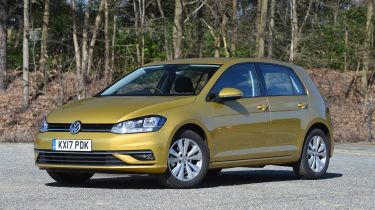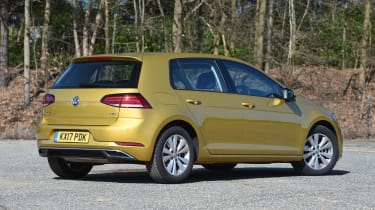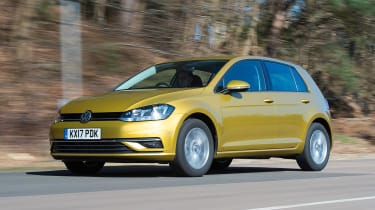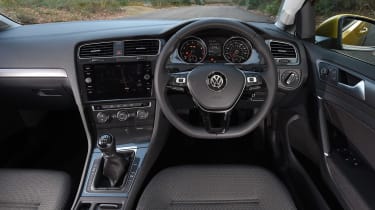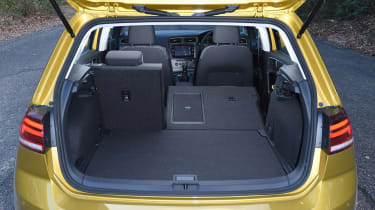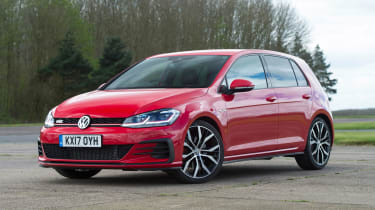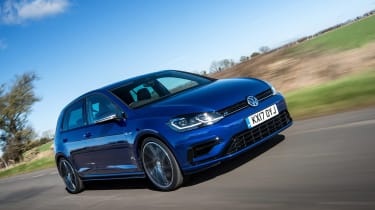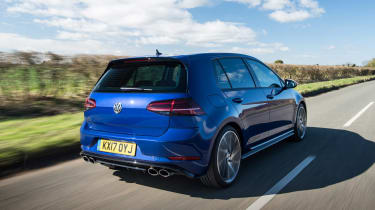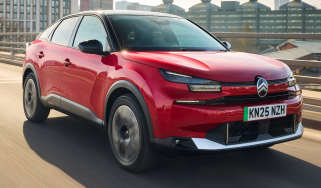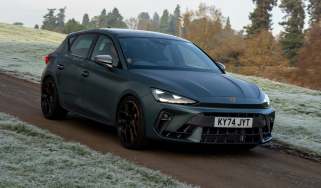Used Volkswagen Golf (Mk7, 2013-2019) review
An impressive all-rounder, the evergreen VW Golf is a family hatchback that blends upmarket premium appeal with everyday practicality and affordable running costs.
Verdict
There's no doubt that the Volkswagen Golf has earned its place at the front of the family hatchback pack. Over 45 years and eight generations it's been a mainstay in the sector, and the seventh-generation model was arguably the best of the bunch.
The Mk7 Golf was launched in 2013 and received a facelift in 2017, but all versions pack the model’s trademark quality, practicality and user-friendly tech. Other strong points include its classy and understated looks, peerless refinement and a wide variety of bodystyles and engines with varying levels of performance and economy. It offered safe yet engaging handling and excellent ride comfort, while a variety of driving aids made it extremely safe yet reasonably enjoyable to drive.
The Golf has always been slightly more expensive to buy than its closest rivals, but used examples hold on to their value like few other mainstream family hatchbacks, so it’s a car that makes sense to the head and the heart. Its appeal is further broadened by the availability of stylish three-door models and even more practical five-door estate versions.
Which one should I buy?
- Best VW Golf for families: 1.0 TSI Match
- Best VW Golf for low costs: 1.0 TSI Bluemotion
- Best VW Golf for towing: 2.0 TDI 150 Alltrack
Used - available now
The Golf Mk7 reached UK showrooms in January 2013. At launch there were three or five-door hatchbacks, as well as a choice of 1.2 TSI or 1.4-litre TSI petrol engines and 1.6 TDI and 2.0-litre TDI diesels. Transmissions included a five or six-speed manual and six or seven-speed twin clutch DSG gearbox.
An 85g/km 1.6 TDI BlueMotion was introduced in May 2013, alongside the 181bhp GTD. At the same time, the GTI hot hatch appeared in regular 217bhp or Performance (227bhp) forms. The 295bhp four-wheel-drive Golf R was introduced in March 2014, just before the Golf Estate, and then a year later the electric e-Golf arrived, with an official range of up to 118 miles.
The plug-in hybrid Golf GTE of March 2015 combined a 1.4-litre TSI petrol engine with a 100bhp electric motor and was capable of around 30 miles in pure EV mode. A 1.0-litre TSI BlueMotion appeared in September 2015 with CO2 emissions of 99g/km.
As all Golf Mk7 engines are turbocharged, even the smallest-capacity units serve up reasonable power, although we’d go for the 1.4 TSI over the 1.2 and the 2.0 TDI over the 1.6 because they’re usefully more muscular yet still economical. The Golf GTE is very impressive, but expensive to buy and rare.
A facelift in 2017 resulted in what is known as the MK7.5 and included some new engines and enhanced technology. The body styles remained the same, but the 1.2-litre TSI was replaced by a 113bhp three-cylinder petrol, while the 1.4-litre was superseded by the 1.5-litre TSI EVO, which features cylinder deactivation technology for enhanced fuel economy.
On top of these changes, the GTI’s power output was raised to 227bhp for the standard version and 242bhp for the Performance Pack upgrade, while the Golf R’s output was briefly increased to 306bhp before returning to 296bhp to meet WLTP efficiency requirements. These go-faster Golfs were also available with a seven-speed DSG automatic for the first time.
Technology was improved on these cars, with more sophisticated and easier-to-use touchscreen infotainment that included better smartphone connectivity, while high-specification models also got TFT digital dials. A new R-Line model combined the sporty looks of the R with the SE’s more cost effective engines.
Also available was the rugged Alltrack model that combined 4Motion all-wheel drive with a raised ride height and tough body cladding. Initially available with the 2.0-litre diesel in either 138bhp manual or 178bhp DSG automatic guises, these were replaced by 148bhp and 181bhp versions in 2017, while a 158bhp 1.8-litre petrol was added a year later.
What are the alternatives?
The Audi A3 uses the same platform and mechanicals as the Golf, but has a plusher cabin. BMW’s 1 Series comes in a variety of bodystyles and is extremely well built, plus it offers some really efficient engines.
Matching the Golf on image but not space is the MINI; while rear seat access is awkward and the boot is small, it’s good to drive and very well built. If practicality is more important, don’t overlook the Ford Focus; it’s a cracking car that’s great to drive, well equipped and reliable. It’s also in plentiful supply and is far cheaper than the Golf. The Vauxhall Astra and Peugeot 308 major on value, but aren’t as well built and aren’t as good to drive.
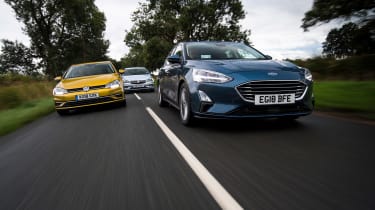
VW Golf vs Ford Focus vs Vauxhall Astra
When the Golf locked horns with these arch rivals in September 2018 the result was closer than you’d think, yet it was the VW that emerged ahead by a nose. It wasn’t quite as fun to drive as the Focus, but it wasn’t far off and hit back with lower running costs and greater practicality than both of its rivals. It also felt the most upmarket and had the best infotainment. Read the full test...
VW Golf vs Kia Ceed vs Hyundai i30
A couple of months later, in November 2018, it was the turn of the Korean Hyundai and Kia twins to challenge the Golf’s supremacy. Both rivals offered more standard kit and lower prices, plus were backed by longer warranties, but neither could match Golf’s winning blend of driver appeal, comfort and quality. Read the full test...
VW Golf vs Toyota Corolla vs Peugeot 308
The Golf faced its sternest test to date in March 2019 when it crossed swords with the Toyota Corolla. With fine driving dynamics, efficient hybrid engine and stylish looks the Japanese car came closest to toppling the classy and comfortable Golf, but in the end the VW’s all-round abilities proved too much as it took another victory. The aging Peugeot trailed home a distant third. Read the full test...
How much will a used Volkswagen Golf cost?
The Golf was never the cheapest option when new, and that’s a theme that continues when buying used. However, the VW’s quality means it feels worth the extra outlay, plus you’ll get more back than rivals when it’s time to sell. Running costs are low, especially for the small petrol and diesels, while most trim levels will give you all the kit you’ll need.
Prices
Stronger resale values than similar era rivals means you’ll have to dig a little deeper into your pockets when buying used. Of course the flipside of this is that you’ll arguably benefit at resale time, so overall you won’t be out of pocket any more than if you’d gone for a less pricey rival.
Diesel-engined versions offer the best value because they’ve suffered in the aftermath of the ‘dieselgate’ scandal. Yet while it was VW that were the main perpetrators of this emissions-cheating scandal, none of the Mk7 Golfs were affected.
Either way, as one of Britain’s best-selling cars of the last decade there should be a huge variety of examples to choose from. Check out our free car valuation tool for the latest prices.
Fuel economy and emissions
Volkswagen has ensured that the Golf is very easy on the wallet – so much so that even the racy 2.0-litre GTI returns impressive economy.
If you’re after properly frugal motoring, choose between either the 1.0-litre petrol with 109bhp or the 114bhp 1.6 diesel. Both have CO2 emissions that range from 104-111g/km – and that’s regardless of whether your gearbox is a manual or a DSG automatic.
In the meantime, the gutsy 1.5-litre unit with 128bhp or 148bhp isn’t bad at avoiding the pumps; its cylinder deactivation technology means it returns claimed figures ranging from 52.3-57.6mpg, depending on gearbox, wheel and body style options, and CO2 emissions are 111-119g/km.
The plug-in hybrid Golf GTE's claimed economy figures are impressive, with the promise of up to 166mpg combined. Like all plug-ins, that figure needs to be taken with a pinch of salt, because to stand any hope of getting close to that figure you need to be able to run on electric power for a large chunk of your commute. When the batteries are drained, you should manage about 55mpg.
The e-Golf is, like most EVs, costly to buy from the outset, but that initial expense can be offset by it costing only a few pounds to fully charge (depending on when and where you charge). Expect around 130-140 miles of range from a charge in the real world, although that varies hugely depending on your driving style and usage.
If you’re really looking to keep bills to a minimum, then the pre-WLTP Bluemotion cars are worth looking out for. Both the early 1.6-litre diesel and later 1.0-litre TSI petrol emit less than 100g/km of CO2, which makes them eligible for free road tax.
Running costs
Golf owners can choose from fixed-interval or variable servicing. The former requires checks every 12 months or 10,000 miles; the latter allows up to 20,000 miles and two years between services, depending on how the car is used.
Once a Golf is three years old, it’s eligible for cut-price maintenance; minor services then cost £159 and major ones £329. Many newer cars have a transferable service plan to cut bills. Most engines feature a cambelt which needs to be replaced every five years or up to 140,000 miles, at £429 (£479 with a new water pump). Brake fluid should be renewed after three years, then every two years, at £59.
All Golfs were covered by a three-year and 60,000-mile warranty when new, the exception being the electric e-Golf which also gets a separate eight-year and 100,000-mile cover for its battery pack.
Insurance ranges from group 11 for the entry-spec Golf 1.0 TSI S (the older 1.2-litre car is in an even lower group) to a sky-high 39 for the rapid Golf R. Insurance quotes are competitive with similar era class rivals, so the perceived prestige of the VW badge doesn't come with any financial penalty.
What do owners think?
Owners love their Golfs, rating their quality and comfort above all else. Yet they also reserve praise for their assured handling, easy-to-use technology, practicality and low running costs. Reliability isn’t perhaps as strong as for similar-era rivals, but most faults tend to be solved quickly and easily.
Reliability
The Mk7 Golf made its debut in 18th place in our Driver Power satisfaction survey in 2014, but by 2021 it had slumped to a disappointing 73rd place. Yet the VW still proved to be a reliable choice with very few problems, while the brand itself scored a more creditable 17th in the manufacturer survey
How practical is it?
While the Golf doesn’t have class-leading interior space, it’s hardly a significant flaw. In both three-door and five-door formats plus a spacious estate, it has plenty of space for five passengers and the boot is well shaped. Visibility is better than most similar-era rivals, too.
Dimensions, cabin and boot space
The Golf seems to grow with each successive generation, and the Mk7 is 150mm longer, 13mm wider and 4mm lower than the Mk6 it replaced in 2013, but it was still far from being a huge car by class standards of the day.
There’s loads of space up front, while rear passengers get plenty of head and legroom. The wide, flat rear seat can take three people without too much of a squeeze, although the centre passenger may find things a bit uncomfortable on longer journeys.
Getting in and out is a simple matter (especially with the five-door), and child seats are easy to fit in the back using either the car’s seat belts or Isofix.
Volkswagen gave the Golf lots of handy storage spaces, including a deep cubby under the front armrest between the driver and front passenger, a large air-conditioned glovebox and numerous cup-holders. Buyers also benefit from vast door bins that are flock-lined to stop their contents from rattling around noisily on the move.
As ever, the large VW boot badge doubles as the tailgate release; open it and there’s a well-shaped, 380-litre boot. Better still, there’s a wide opening and low load lip, while you have a handy hidden storage area below the height-adjustable false boot floor.
If you need more room, you can liberate a generous 1,270 litres of capacity by folding the 60:40 rear seats; the load platform is usefully flat, too. Useful additions to the load space include a 12V power supply and a pair of bag hooks, plus there’s a ski-flap for longer items.
Those looking for even more practicality can opt for the Estate model, with a big 605-litre boot that expands to 1,620 litres with the rear seats folded flat. The Alltrack version retains this practicality, but adds a raised ride height and four-wheel drive for added versatility.
It's worth noting that the e-Golf and GTE are slightly less practical, because their batteries are mounted under the boot floor. As a result, the e-Golf gets a 343-litre load bay, while the hybrid GTE’s shrinks to 272 litres. That’s still a very usable amount of space, but you sacrifice any form of under-floor storage.
Equipment and technology
Entry-level S and SE trim levels were originally fitted with a small 5.8-inch infotainment screen with Bluetooth connectivity, while a popular 8-inch upgrade added DAB radio and the possibility of sat-nav on some models.
The 2017 facelift added an eight-inch Composition set-up to all models, with a DAB radio, Bluetooth and a USB connection, plus the brand’s Think Blue trip computer that gives tips on efficient driving. SE models and above added the desirable Car Net ‘App Connect’, which brings Apple CarPlay and Android Auto smartphone apps, although the online services cost extra to subscribe to.
All versions get sharp graphics and a straightforward menu system, while a neat motion sensor brings up hotkeys when your hand approaches the screen and the touch menu buttons respond well. It was one of the easiest and most intuitive systems available at the time.
Some models are fitted with an optional 9.2-inch screen, gesture control and a 64GB memory. But in reality, the standard system delivers all the features you’ll need and is easier to use than this all-touchscreen affair.
The entry-level S trim level is spartan, although it has a DAB radio and colour touchscreen display, air-con plus electric mirrors and front windows. SE spec adds powered rear windows, 16-inch alloy wheels and emergency city braking, while the GT has 17-inch alloys, sports suspension plus front and rear parking sensors.
The mid-range, high-value Match, introduced in July 2014, came with parking sensors all-round and electrically folding door mirrors. The GTI was identified by its red grille stripe and twin exit exhausts, while inside it gets the trademark tartan checked trim. By contrast the faster R was more subtle, but got four exhausts and silver-finished door mirrors.
The trim levels remained largely unchanged for the 2017 facelift, with the exception of the new R-line, which was based on the GT and added decorative inserts in the dash and door panels, along with a different design of 17in wheel and trapezoidal exhaust pipes.
Safety
The Golf has always had a strong safety record and the MK7 is no exception. All cars get seven airbags (including driver’s knee airbag), while the five-star Euro NCAP rating earned in 2012 is impressive, especially the 94% rating for adult occupant protection.
Standard safety gear across the range includes an electric parking brake with auto hold function, electronic tyre pressure monitoring, stability control, front passenger airbag deactivation and hydraulic brake assist.
All but entry-level S editions get Front Assist, which now incorporates city emergency braking and pedestrian detection.
Safety options include lane assist with side scan, blind spot monitoring and dynamic light assist, park assist and rear side airbags.
What’s it like to drive?
While not as exciting to drive as similar-era rivals such as the Ford Focus, the Golf is composed and comfortable. It’s backed by a great range of turbocharged engines and packs the sort of refinement normally reserved for more expensive models.
Engines and performance
The Golf features a wide range of engines and is one of the only mainstream cars of the time to offer the choice of petrols, diesels, a plug-in hybrid and a full-EV.
The petrol engines are badged TSI and they start with a 1.2-litre four-cylinder with either 84bhp or 104bhp. It was replaced in 2017 by a 1.0-litre three-cylinder that was available with similar outputs (84bhp and 109bhp)
The 84bhp unit was available in S trim only, but to best combine power, efficiency, kit and price, you’ll need to step up to the more powerful versions that retain the refinement of the base car, but add useful extra punch for overtaking or carrying heavier loads.
Despite its diminutive capacity, the 109bhp 1.0-litre turbocharged engine puts on a strong show. We recorded a 0-60mph time of 9.6 seconds in one, which was half a second faster than a more powerful 1.0-litre turbo Honda Civic, while it had a larger-capacity Renault Mégane 1.2 TCe beaten during our in-gear assessments. For instance, it covered the fourth gear 30-50mph increment in 5.6 seconds, which was 1.1 seconds ahead of the Mégane.
The more powerful 120bhp 1.4-litre TSI will be a better bet for many, but if your budget stretches then the 1.5-litre TSI found in post-2017 facelift models is a great all-round choice.
When we tested this engine against a 1.4 turbo Vauxhall Astra, the VW was quicker than the Astra from 50 to 70mph in top gear, completing this acceleration test in 8.7 seconds compared with 9.2 seconds for the Vauxhall.
In the lower gears, where the Vauxhall’s revs were higher, the Astra was faster than the Golf. The VW accelerated between 30 and 50mph in third and fourth gears in 4.2 and 5.5 seconds respectively, whereas the Astra needed only 3.9 and 5.4 seconds for the same test.
The 2.0-litre petrol engine is reserved for the GTI and R models, with outputs from 217bhp to 306bhp. It’s a smooth and very flexible engine that offers incredible acceleration, making these cars some of the fastest on the road. For example, the DSG-equipped R is capable of the 0-62mph sprint in just 4.7 seconds.
On the diesel side, there’s a 1.6 that was originally available with 104bhp before being increased to 114bhp for 2017. It’s capable enough for most uses, but if you want something with a little more guts (and a little less noise), VW offers a 2.0 diesel producing 148bhp and barely any more CO2. There’s also a potent 181bhp 2.0, but it’s reserved for the GTD.
The GTE plug-in hybrid mixes a 1.4-litre petrol and an electric motor for a combined output of 201bhp, while the e-Golf has a 124-mile range which was increased to 186 miles as part of the 2017 update. It also benefited from a power upgrade from 113bhp to 134bhp, although both are smooth, brisk and easy to drive.
With the exception of the five-speed manual in the entry-level 1.6 TDI, the standard gearbox across the Golf range is a six-speed manual. But one key switch of the 2017 facelift was the phasing out of the old six-speed dual-clutch DSG automatic in favour of a smoother-shifting seven-speed unit across all models.
Don’t discount the Alltrack version, which while rare is an excellent all-rounder. Its jacked-up suspension and four-wheel drive make it a surprisingly capable off-roader as well as an excellent tow car. It’s also smooth and poised on the road, where the turbocharged petrol version offers a decent blend of performance and refinement.
On the road
The Volkswagen Golf has always delivered high levels of comfort, refinement and handling poise, and the Mk7 is no exception. Enter a series of corners and the Golf responds swiftly to the direct and well-weighted steering. There’s also bags of grip and rock-solid body control, which make the VW a confidence-inspiring machine.
Better still, this agility is matched to impressive refinement and comfort. The ride isn’t as soft as a Renault Megane’s, but it’s better controlled over big bumps, while engine, wind and road noise are isolated from the cabin. Progress is even more fluid in models fitted with the optional adaptive damping system, and are worth seeking out.
The direct and well-weighted steering means the Volkswagen responds well on turn-in, plus there’s plenty of grip and good body control. It’s not quite as engaging to drive quickly as a Honda Civic, but there’s not much in it. The Golf’s real strength is the way it blends that ability with refinement and comfort; it rides more smoothly than a Peugeot 308 in particular, absorbing bumps in the road surface admirably.
Volkswagen fitted all Golf models with more than 118bhp with a more sophisticated multilink rear axle to help improve handling – although in most situations the standard torsion beam set-up feels nearly as composed.
If fun is top of your priority list, then look for a GTD, GTE, GTI or R version, with the GTD offering plenty of torque for effortless overtaking. Don't be fooled by the plug-in hybrid GTE though: despite the name, it's no hot hatch. It's faster in a straight line than the GTD, but the added weight means it's not much fun in the corners.
True performance fans will be drawn to the flagship R model. Available as a hatchback or an estate, the Golf R gets up to 306bhp and four-wheel drive, so it’s very sharp to drive and packs a tremendous amount of grip.
What should you look out for?
The Golf is a thoroughly engineered hatchback that’s been perfected over the decades, so glitches are few and far between. However, there are one or two issues to keep an eye out for.
Common used Volkswagen Golf Mk7 problems
Wipers
The driver’s side wiper can smear the windscreen when it rains. Switching the original Valeo blades for Bosch alternatives seems to do the trick.
Parking brake
While the electronic parking brake has so far proven reliable, it seems to be something that really polarises opinion; owners either love it or hate it.
Infotainment
The touchscreen multimedia system generally works well, but some drivers have struggled to pair their phones and it doesn’t read all MP3 players.
Headlights
Lots of owners aren’t impressed by the Golf’s standard halogen headlights, so bulb swaps are common, usually for Osram Nightbreakers.
Recalls
The Golf Mk7 has been recalled jon a few occasions but they have usualy affected only a small number of cars. A total of 303 cars built in April 2015 were called back because of a risk of the suspension collapsing caused by a manufacturing fault with the front wheel bearing housing. Any affected cars got new castings made to a higher standard.
In 2017 there were recalls relating to wheel bearing housings, the ABS and ESC stability control systems, the headlights and the airbags on some models.
Volkswagen issued a recall in March 2016 for 2.0 TDI Golfs, as part of its high-profile emissions debacle. But this was aimed at the Mk6 with the EA189 unit; the Mk7 uses the EA288 diesel, so it isn’t affected by this recall.
